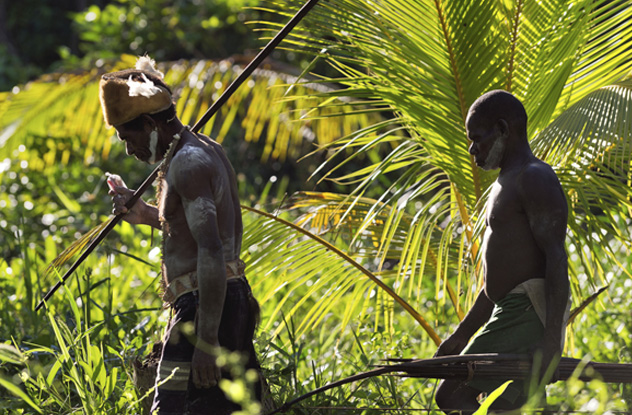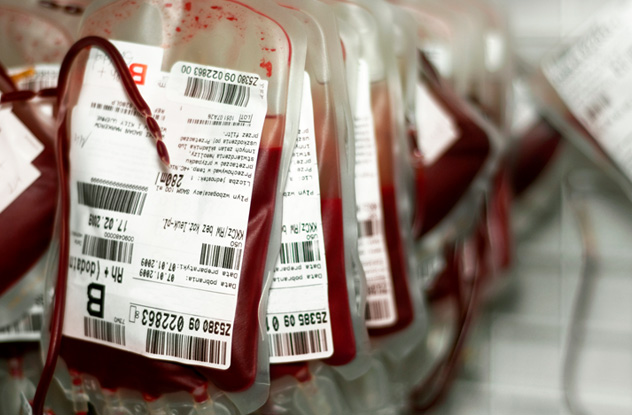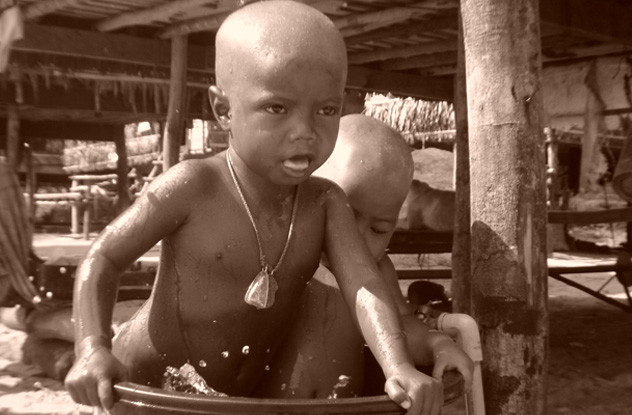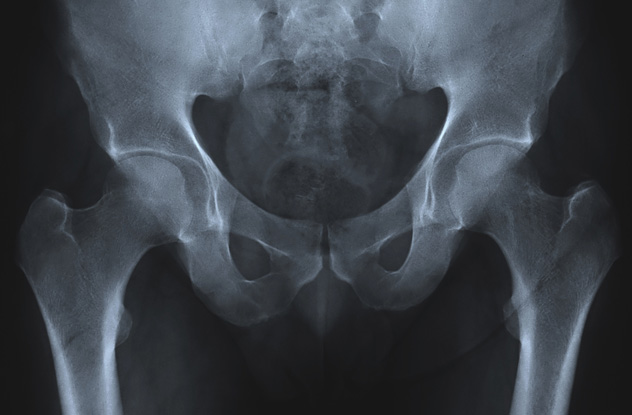5.Immunity To A Brain Disease
5.对脑疾病拥有免疫力
In case we needed another reason to avoid cannibalism, eating our own kind is not a particularly healthy choice. The Fore people of Papua New Guinea showed us as much in the mid–20th century when their tribe suffered through an epidemic of Kuru—a degenerative and fatal brain disease spread by eating other humans.
如果我们要给避免同类相食增加一个理由的话,从健康的角度来看,这不是一个好的选择。巴布亚新几内亚" Fore"族人在20世纪中期流行的库鲁病很好地说明了这一点,他们因同类相食,产生了退化性和致命性的脑疾病。

Kuru is a prion disease related to Creutzfeldt-Jakob Disease (CJD) in humans and bovine spongiform encephalopathy (mad cow disease). Like all prion diseases, kuru decimates the brain, filling it with sponge-like holes. The infected suffers through a decline in memory and intellect, personality changes, and seizures. Sometimes, people can live with a prion disease for years, but in the case of kuru, the afflicted usually die within a year of showing symptoms. It's important to note that, although very rare, a person can inherit a prion disease. However, the illness is most commonly spread by eating an infected person or animal.Initially, anthropologists and medical doctors didn't know why kuru was spreading across the Fore tribe. Finally, in the late 1950s, it was discovered that the infection was being transmitted at mortuary feasts, where tribe members would consume their deceased relatives out of respect. Mostly women and young children participated in the cannibalistic ritual. Consequently, they were the ones predominantly affected. Before the funerary practice was banned, some Fore villages had virtually no young women remaining.But not all who were exposed to kuru died from it. Survivors had a novel variation in a gene called G127V that made them immune to the brain disease. Now, the gene is widespread among the Fore and surrounding people, which is surprising because kuru only popped up in the area around 1900. This incident is one of the strongest and most recent examples of natural selection in humans.
库鲁病是一种与库兹菲德-雅各氏症和疯牛病有关的朊病毒疾病。和所有朊病毒疾病一样,库鲁病杀死大量脑细胞,使其产生空洞、海绵化。患者会记忆衰退,智力下降,性格改变,产生癫痫等。通常,患有朊病毒疾病的人可以继续生活数年,但是患有库鲁病,则一般在产生症状之后一年内便会死亡。需要注意的是(尽管非常罕见),朊病毒能够遗传。不过,绝大多数患者是因为食用了产生感染的人或动物。最初,人类学家和医生们都不知道为什么库鲁病会在Fore族人中大肆传播。直到20世纪50年代末才发现这类疾病是在太平间盛宴时传染的。因为出于对死去亲人的尊敬,Fore族人会将尸体吃掉。妇女、孩子都参加此种仪式,高峰时该病在女性和儿童中的发病率是在男性中的8至9倍。因为该族人吞食已逝亲属的肉以完成后者的"生命循环"时,由男性先选择所食部分,然后再由女性和儿童打扫剩下的包括脑部在内的人肉,而脑部正是致病朊毒体含量较高的部分。在这种食人习俗被禁止之前, Fore族人的一些村庄几乎连一个年轻妇人都没有。并不是所有患此病的人都会死亡,这些存活下来的幸存者们的G127V基因有了新变化,这使得他们对大脑疾病产生了免疫能力。现在,这种基因遍布Fore族和周围的人。这是令人十分惊奇的现象,因为库鲁病是在1900年才开始爆发的。这个例子是自然在人类身上做出选择的最强和最近的例子。
4.黄金血

Although we're often told that type O blood is a universal blood type that anyone can receive, that's not the case. In fact, the whole system is a bit more complicated than many of us realize.
我们都知道O型血是所有人都可以接纳的血液,然而这并不是事实。事实上,血液分类的系统比我们所知道的要复杂得多。
While most of us are aware of the eight basic blood types (A, AB, B, and O—each of which can be positive or negative), there are currently 35 known blood group systems, with millions of variations in each system. Blood that doesn't fall into the ABO system is considered rare, and those who have such blood may find it challenging to locate a compatible donor when in need of a transfusion.Still, there's rare blood, and then there's really rare blood. Presently, the most unusual kind of blood is known as "Rh-null." As its name suggests, it doesn't contain any antigens in the Rh system. It's not that uncommon for a person to lack some Rh antigens. For instance, people who don't have the Rh D antigen have "negative" blood (e.g. A-, B-, or O-). Still, it's extremely extraordinary for someone to not have a single Rh antigen. It's so extraordinary, in fact, that researchers have only come across 40 or so individuals on the planet who have Rh-null blood.What makes this blood even more interesting is that it totally beats O blood in terms of being a universal donor, since even O-negative blood isn't always compatible with other types of rare negative blood. Rh-null, however, works with nearly any type of blood. This is because, when receiving a transfusion, our bodies will likely reject any blood that contains antigens we don't possess. And since Rh-null blood has zero Rh, A, or B antigens, it can be given to practically everyone. Unfortunately, there are only about nine donors of this blood in the world, so it's only used in extreme situations. Because of its limited supply and enormous value as a potential lifesaver, some doctors have referred to Rh-null as "golden" blood. In some cases, they've even tracked down anonymous donors (a big no-no) to request a sample.Those who have the Rh-null type undoubtedly have a bittersweet existence. They know that their blood is literally a lifesaver for others with rare blood, yet if they themselves need blood, their options are limited to the donations of only nine people.
我们都非常了解8种基本的血型(A、B、AB、O,每一血型有正负之分),事实是,现在已经发现的血型系统一共有35个,每一个系统又有上百万种变体。不包括在ABO血型系统的血型被认为是稀有血型,稀有血型的人会发现当他们需要输血的时候,要找到一个适配的血型非常困难。在稀有血型之中,还有极其稀有的血型。比如说,Rhnull血型。正如它的名字所显示的,它在Rh血型中不会产生任何的抗原。某人缺少一些Rh抗原并不奇怪,例如,缺少Rh D抗原的人就是负的血型(A-、B-、O-等)。然而,一个完全没有Rh抗原的人是特别难以找到的。研究者们在整个地球上都仅仅发现40个左右的人拥有Rh-null血型。Rhnull血型之所以如此吸引人们好奇心的是:它比O型血适配血型还广,因为O型血和稀有血型中的负血型并不适配,Rhnull血型却几乎能跟所有血型适配。Rhnull血型之所以如此广泛地适配是有原因的。当接收到输入的血液时,人体会自动排斥它原本不具有的抗原。Rhnull血型没有Rh、A、B型抗原,因此它可以被输送给任何人。不幸的是,整个世界上Rhnull血型的献血者只有9个人,他们的血液因此也只有在极端情况下才会用到。由于Rhnull血型血液的广泛适配性以及它可能被作为拯救生命之血的这种极大潜质,它被某些医生称作"黄金血液"。某些时候医生们甚至会跟踪匿名的Rhnull血型献血者以求能采集到一份样本(当然,这是绝对不可以做的事情)。拥有Rhnull血型的人对于他们自己的血液的感受可以说是喜忧参半。一方面,他们知道自己的血对于别人来说可能是救命神血,但另一方面,如果他们自己病了需要输血的话,他们能够指望的也就只有世界上仅存的那九个Rhnull血型的捐献者。
3.Crystal-Clear Underwater Vision
3.在水下拥有水晶般透明的视力

Most animals' eyes are designed for seeing things underwater or in air—not both. The human eye, of course, is adept at seeing things in air. When we try to open our eyes underwater, things look blurry. This is because the water has a similar density to the fluids in our eyes, which limits the amount of refracted light that can pass into the eye. Low refraction equals fuzzy vision.
很多动物的眼睛是被设计来看清在水底或者空气中的事物的——不能够兼顾。人类的眼睛擅长于看清空气中的东西。当我们身处水下,试着睁开眼睛,我们便会发现,眼前模糊不清。这是因为水的密度与我们眼睛里液体的密度相当,这限制了眼睛折射光线的数量,从而导致视线模糊不清。
That knowledge makes it all the more surprising that a group of people, known as the Moken, have the ability to see clearly underwater, even at depths up to 22 meters (75 ft). The Moken spend eight months of the year on boats or stilt houses. They only return to land to get essential items, which they acquire by bartering foods or shells collected from the ocean. They gather resources from the sea using traditional methods, which means no modern fishing poles, masks, or diving gear. Children are responsible for collecting food, such as clams or sea cucumbers, from the sea floor. Through this repetitive and consistent task, their eyes are now capable of changing shape when underwater to increase light refraction. Thus, they can easily distinguish between edible clams and ordinary rocks even when many meters below water.When tested, the Moken children had underwater vision twice as sharp as European children. However, it seems that this is an adaptation that we might all possess if our environment demanded it, since researchers have trained European children to perform underwater tasks as successfully as the Moken.
这就使得当我们得知莫肯人能够在水下(甚至是22米深的水下)将事物看得一清二楚时感到吃惊不已。莫肯人一年中有8个月的时间在船上度过。除了获取一些必备生活用品之外,他们很少返岸。他们用传统的方法在海上捕捞。这意味着他们不使用包括钓竿、面具、潜水装置等一切现代捕鱼工具。孩子们负责从海底收集蛤和海参等食物。这种工作每日不断重复,最终使得他们的眼睛在水下具备了可以改变形状从而增加光反射的能力。因此,他们能够轻易分别出水下的蛤和石块,获取食物。经过试验,莫肯人孩童的水下视力是欧洲孩童的两倍。不过,这似乎是每个人都能够拥有的能力,只要我们改变环境,同样也会产生相应的变化。研究者们训练欧洲孩童向莫肯人孩童一样在水底不停地作业,最终成功地证明了这点。
2.高密度骨骼

Getting old comes with a host of physical problems. A common such issue is osteoporosis, a loss of bone mass and density. This leads to inevitable bone fractures, broken hips, and hunched spines—not a pleasant fate for anyone. Still, it's not all bad news, as a group of people have a unique gene that may hold the secret to curing osteoporosis.
变老伴随着一系列身体问题。一个常见的问题就是骨质疏松症,骨质流失和空隙增大。这将会导致骨折、髋部损坏、驼背等。不过,也不全然是坏消息,因为有人拥有特殊的基因能够将其治愈。
The gene is found in the Afrikaner population, and it causes people to gain bone mass throughout their lives instead of losing it. More specifically, it's a mutation in the SOST gene, which controls a protein (sclerostin) that regulates bone growth. If an Afrikaner inherits two copies of the mutated gene, they develop the disorder sclerosteosis, which leads to severe bone overgrowth, gigantism, facial distortion, deafness, and early death. Obviously, that disorder is far worse than osteoporosis. However, if they only inherit one copy of the gene, they don't get sclerosteosis and simply have especially dense bones throughout their lives.Although heterozygous carriers of the gene are currently the only ones enjoying the benefits, researchers are studying the DNA of Afrikaners with hopes of finding ways to reverse osteoporosis and other skeletal disorders in the general population. Based on what they've learned so far, they've already started clinical studies on a sclerostin inhibitor that's capable of stimulating bone formation.
这种基因在阿非利卡人上发现,它使人们在一生中增加骨量而不是失去。确切地说,它是SOST基因变异,这种基因控制着管理骨头增长的蛋白质。如果阿非利卡人遗传了两对突变基因,那么他们会患上障碍性的硬化性骨化病,这会导致严重的骨质增生、巨人症、口眼歪斜、失聪和早逝。很明显,这个障碍远比骨质疏松症要严重。然而,如果他们只是遗传了一对突变基因,那么他们不会患上骨质疏松症且他们在一生中仅有密质骨。虽然目前仅有该基因的杂合子携带者能从中受益,但研究员已经在研究阿非利卡人的DNA,希望能够找到方法来逆转骨质疏松症和普通人群中的其它骨骼疾病。基于他们现在所掌握到的,他们已经开始了关于可促进骨形成的硬化蛋白抑制剂的临床研究。
1.睡眠需求减少

If it ever seems like some people have more hours in their day than you do, it turns out they just might—at least more awake hours. That's because there are unusual individuals who can operate on six or fewer hours of shut-eye a night. And they aren't simply getting by—they thrive on this limited amount of sleep, while many of the rest of us are still dragging ourselves out of bed after snoozing for eight solid hours. These people aren't necessarily tougher than the rest of us, and they haven't trained their bodies to function on less sleep. Instead, they have a rare genetic mutation of the gene DEC2, which causes them to physiologically need less sleep than the average person.If normal sleepers were to stick to six or fewer hours of slumber, they'd start experiencing negative impacts almost immediately. Chronic sleep deprivation can even lead to health problems, including serious ones like high blood pressure and heart disease. Those with the DEC2 mutation don't have any of the problems associated with sleep deprivation, despite the limited time their heads are on the pillow. While it might seem odd that a single gene could change what we believe is a basic human need, those studying the DEC2 mutation believe it's helping people to sleep more efficiently with more intense REM states. Apparently, when we have better sleep, we need less of it.This genetic anomaly is exceedingly rare and is only found in less than 1 percent of self-proclaimed short-sleepers. So, chances are, even if you think you have it, you probably don't.
如果有些人的一天似乎比你的要长,那么他们可能只是有更多醒着的时间。那是因为有一些独特的人,他们一个晚上只需要六个小时甚至更少的睡眠时间。他们仅靠有限的睡眠时间就可以维持一天,然而,我们当中的许多人在睡了整整八个小时后仍然要挣扎着将自己拖出床外。这些人并不是比我们当中的其他人都更顽强,也没有训练自己的身体去适应更少的睡眠,而是拥有罕见的突变基因DEC2,这种基因能使他们在生理上比普通人需要更少的睡眠。如果普通人要坚持只睡六个或少于六个小时,那么他们几乎是立即就会开始体验到负面影响。长期的睡眠不足甚至会导致一些健康问题,包括一些严重的问题诸如高血压、心脏病。虽然那些携带DEC2突变基因的人睡觉时间有限,但是他们并没有因为睡眠缺失而产生任何问题。单基因能够改变我们所相信的一个人基本的需求,尽管这听起来似乎很奇怪,然而研究者认为DEC2帮助人在快速眼动睡眠状况下睡得更有效率。很显然,我们睡得越好,我们就越不需要它。这种基因异常极其稀有,仅仅在不到百分之一的自称短睡眠者身上发现。所以,即使你认为你有这种基因,你可能并没有。
翻译:烟囱、徐杉、欧阳远丽、阿饭、孟庆润 来源:前十网

















